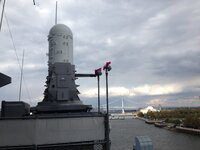Glider
Major
Be fair I did say Quite a good AA component.There may be some argument as to the AA component. The 5.25 was biased more than bit heavily towards surface fire. yes the AA suite was better than most of the old WW I battleships but it was not anywhere near as good as few other RN ships or the newer American ships. The set up in the Valiant might well have been much better.
As for the 5.25 vs 4.5 or 5in guns debate, without proximity fuses I don't think it would have made much of a difference but I agree 20 x 4.5in would have been better.
In Dec 1941 which is when the POW was sunk the LAA component of the N Carolina was 16 x 1.1in (4 x 4) and 12 0.5in HMG (12 x 1). Compared to the 48 x 2pd (6 x 8), 1 x 40mm, approx 16 x20mm (16 x 1) on the POW, the N Carolina on completion, was poorly defended.
Whatever the differences had they survived the initial attack I still believe it would simply have delayed the inevitable.








